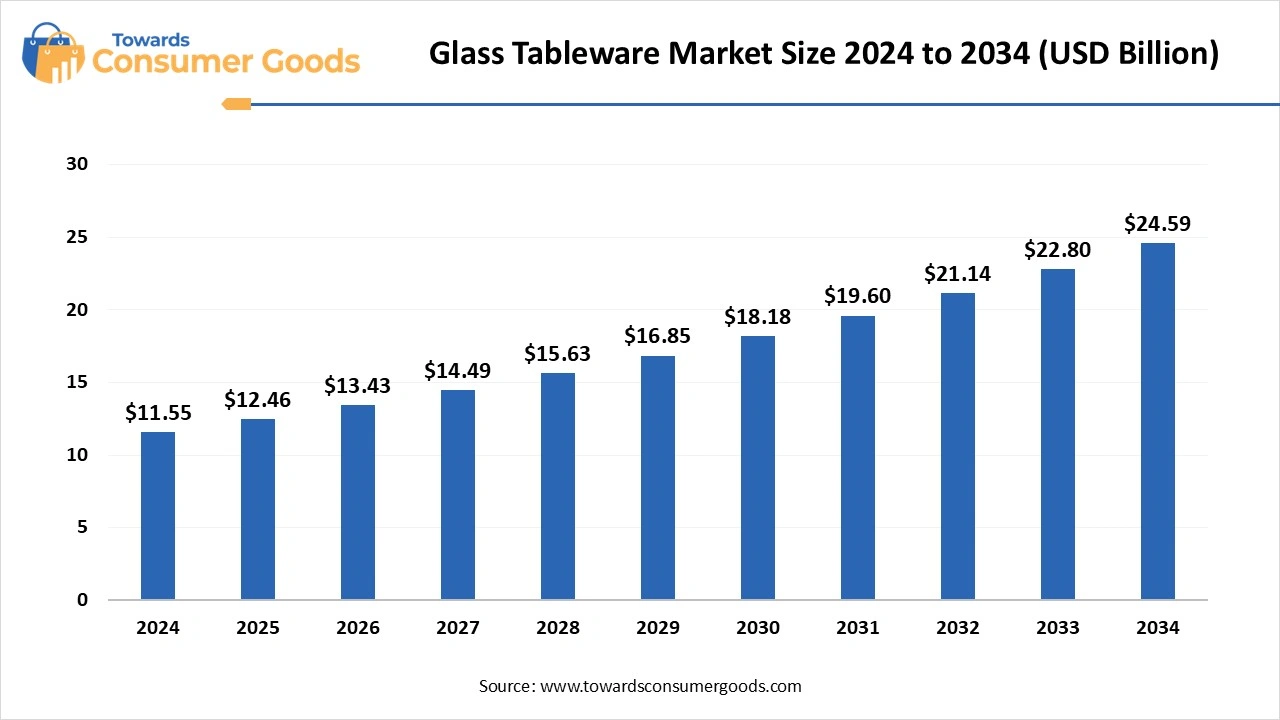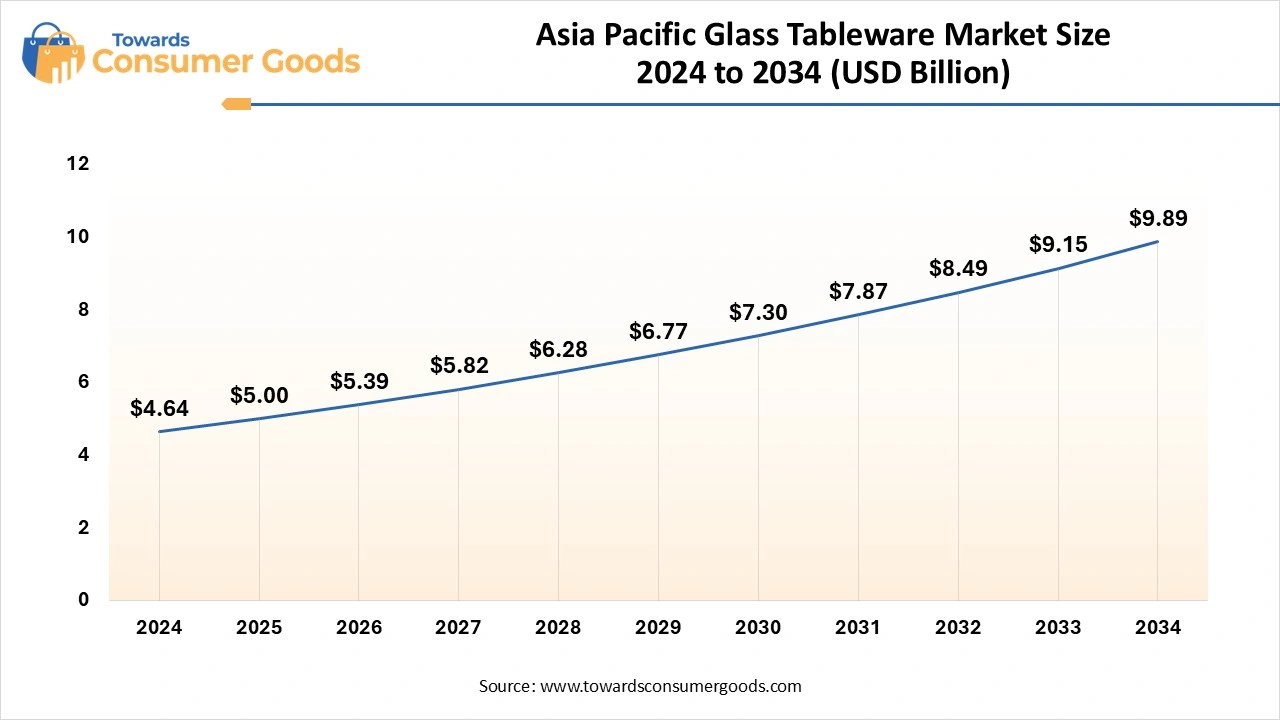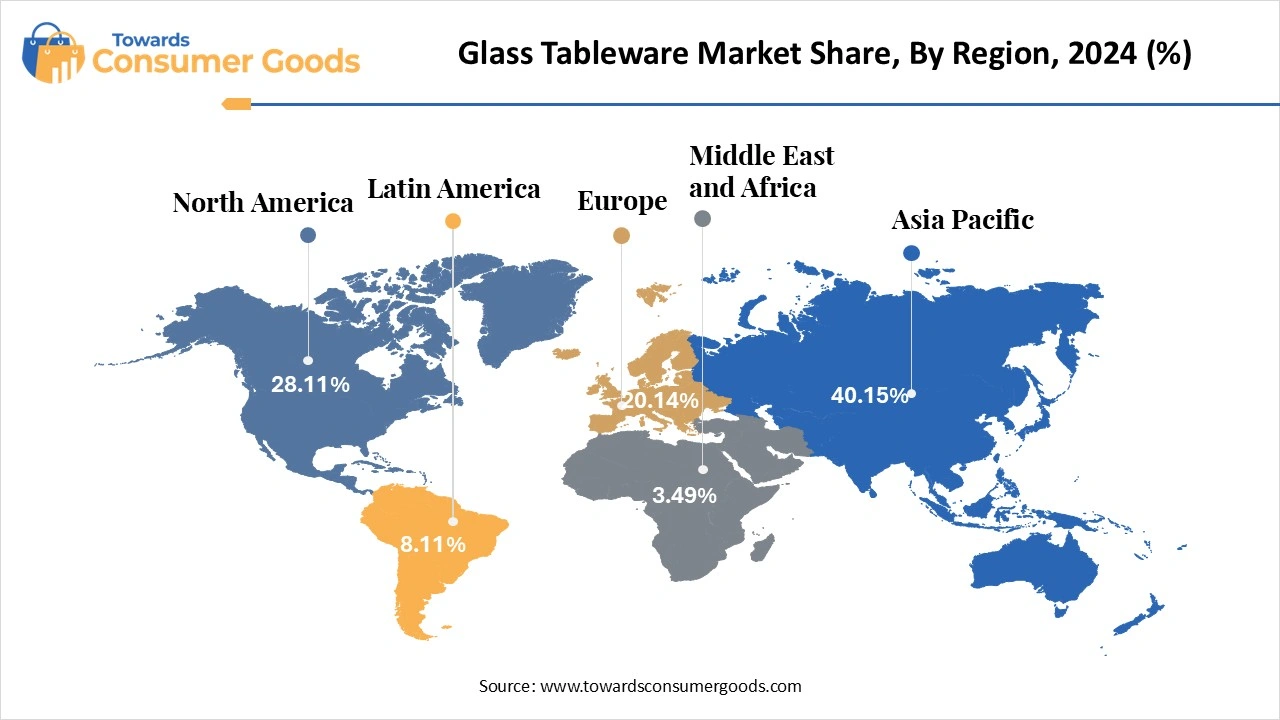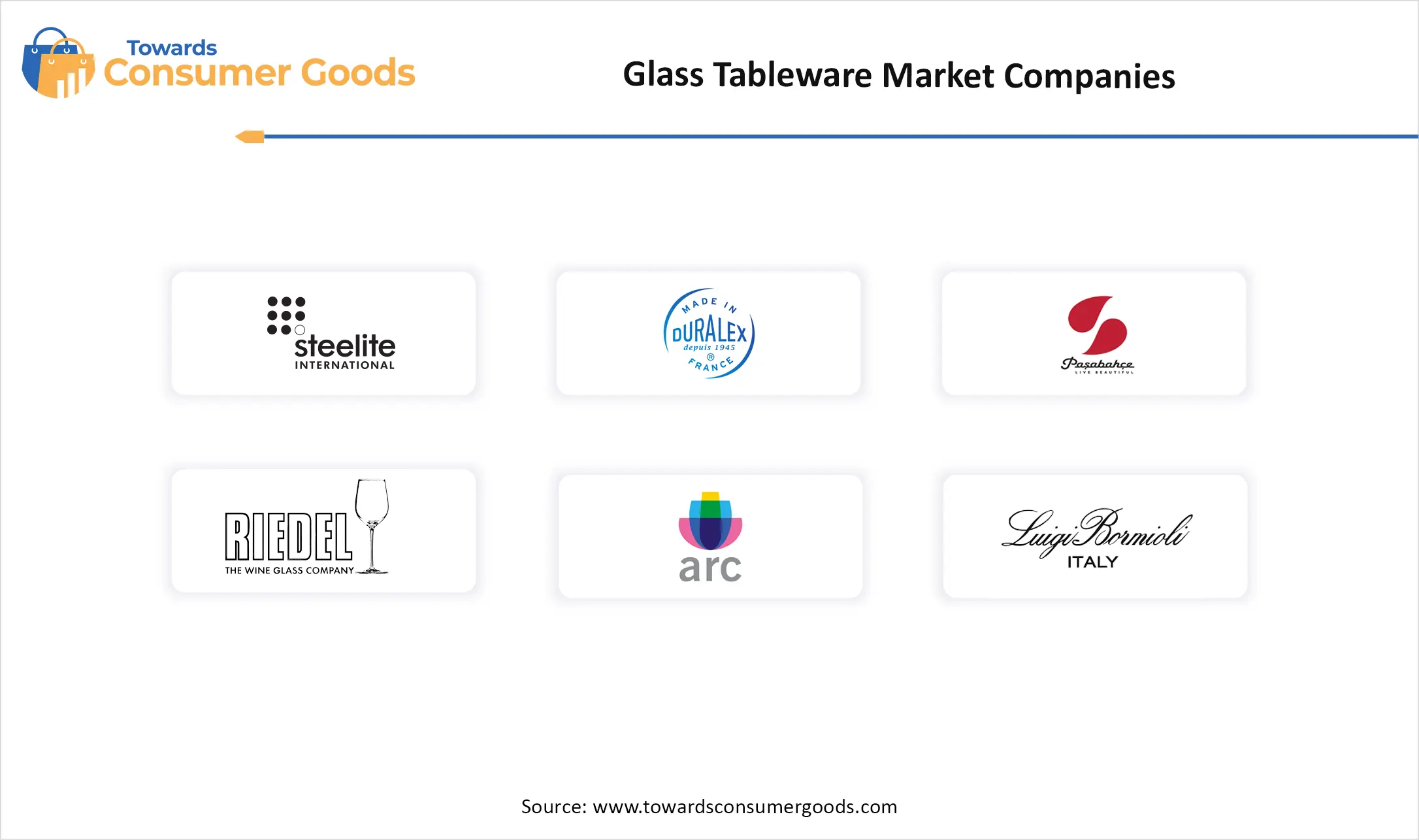June 2025
The global glass tableware market size was valued at USD 11.55 billion in 2024 and is expected to reach around USD 24.59 billion by 2034, growing at a CAGR of 7.85% from 2025 to 2034. The glass tableware market continues to thrive as the perfect confluence of aesthetic appeal, durability, and functional design. From casual home dining to fine hospitality settings, glassware remains an essential choice, evolving with lifestyle trends and consumer preferences.

The global glass tableware market is undergoing a refined transformation, driven by a blend of design innovation, sustainability consciousness, and changing dining cultures. Traditionally associated with elegance and formality, glassware is now permeating everyday lifestyles, redefining table aesthetics in homes, cafes, restaurants, and corporate spaces alike. The rise of urban middle-class households and increased spending on premium home products are surging interest in aesthetic food presentation, driven by social media and experiential dining trends. Preference for eco-friendly and non-toxic materials, positioning glass as a superior alternative to plastic or disposable wares. Moreover, innovations such as tempered glass for enhanced durability, microwave-safe coatings, and custom decorative designs are expanding the versatility and appeal of glassware across traditional and contemporary dining formats.
| Report Attributes | Details |
| Market Size in 2025 | USD 12.46 Billion |
| Expected Size by 2034 | USD 24.59 Billion |
| Growth Rate from 2025 to 2034 | CAGR 7.85% |
| Base Year of Estimation | 2024 |
| Forecast Period | 2025 - 2034 |
| Dominant Region | North America |
| Segment Covered | By Product Type, By Material, By End-user, By Distribution Channel, By region |
| Key Companies Profiled | Natracare Ltd., Cora, Inc., Seventh Generation, Inc., The Honest Company, Inc., Rael, Inc., Highamp Srl, Lunapads International, Inc., Happy Period, Inc., Greenspace Brands Inc.,Organic Initiative |
| 25-40 years (millennials) | 41-60 years (established individuals) |
| Urban professionals, young couples, and first-time homeowners. Aesthetics-driven, prefer minimalist or contemporary glassware sets. This focuses on home décor, entertaining guests, and social media. | Mature buyers, often responsible for household purchases and prioritize durability and multi functionality, and in family gatherings and festive hosting too. |
Cracking the Code of Conscious Consumption
The glass tableware market is experiencing a significant surge in opportunities, largely driven by the rising tide of sustainability and conscious consumerism. As global awareness about environmental preservation intensifies, consumers are actively seeking alternatives to plastic and disposable materials, placing glass at the forefront due to its eco-friendly attributes. Glass is not only non-toxic and recyclable but also offers long-term usability, which aligns with the values of modern households aiming for both style and responsibility. Additionally, hospitality and foodservice industries are embracing this transition, incorporating elegant and reusable tableware to support green dining initiatives.
The growing interest in artisanal and handcrafted glassware among millennials and Gen Z consumers has further opened premium market segments that value design, uniqueness, and sustainability. The combination of aesthetic appeal with ecological consciousness presents an ideal space for innovation, such as temperature-sensitive coatings, ergonomic designs, and smart functionalities. Altogether, the intersection of environmental responsibility, design sensibility, and evolving lifestyle trends creates a fertile landscape for the glass tableware market to flourish.
Fragile Perceptions in a Price-Sensitive Landscape
Despite its charm and eco-benefits, the glass tableware market continues to face a few significant restraints that temper its full potential. One of the most common consumer concerns is the perceived fragility of glass. Many buyers, particularly families with young children or high-traffic households, hesitate to invest in glass products, fearing breakage and frequent replacement. This concern is magnified in regions where consumer purchasing power is limited, as affordability often trumps elegance or sustainability. Additionally, glass is inherently heavier and more delicate to transport, making packaging and logistics a costly affair compared to lighter alternatives like melamine or plastic. These factors reduce the appeal of glassware in rural and semi-urban markets where practicality outweighs presentation.
Compounding the issue is the rising competition from innovative substitutes such as bamboo fibreware, biodegradable plastics, and stainless-steel tableware, which offer higher durability and are often perceived as more suitable for daily use. Without targeted education about the long-term benefits of glass, including health, safety, and environmental impact, consumer preference in many markets may continue to lean towards cheaper and more robust options. Therefore, overcoming these limitations requires strategic communication, durability-focused innovation, and price-sensitive market expansion to make glass tableware a more universally appealing choice.
Why Is Asia-Pacific Leading the Glass Tableware Revolution?
The Asia-Pacific region stands at the forefront of the global glass tableware market, emerging as the dominant force due to its vast population base, dynamic consumer behavior, and rapid urbanization. Countries such as India, China, Japan, and South Korea are witnessing rising disposable incomes and a growing inclination toward premium home décor, elevating the demand for aesthetically appealing tableware. Cultural traditions across many Asian countries place a high value on hospitality and presentation, making elegant and functional tableware a household staple. Additionally, the surge in middle-class homeownership and an increase in nuclear family units have amplified the demand for compact, affordable, and durable dining solutions. The region is also benefiting from being a global manufacturing hub, with domestic and export production units efficiently serving the international market at competitive prices.

Moreover, local glass manufacturers are increasingly investing in automation, energy-efficient production, and eco-conscious packaging, aligning with global sustainability goals. The booming e-commerce sector, especially in urban centers, is further enabling customers to access a wide range of designs, pushing sales volumes steadily upward. Collectively, these factors firmly establish Asia-Pacific as the leading and most influential region in the glass tableware industry.
Is Europe the New Hotspot for Luxury and Sustainable Tableware?
Europe is rapidly emerging as the fastest-growing region in the glass tableware market, driven by its deep-rooted appreciation for artisanal craftsmanship and sustainable consumer habits. The demand across European countries is increasingly shaped by a desire for premium, ethically produced, and design-rich products, qualities that glass tableware uniquely embodies. Scandinavian minimalism, French elegance, and Italian flair are influencing both local production and consumer preferences. European consumers, especially in Western Europe, are showing a strong affinity for recycled and lead-free glass, handcrafted aesthetics, and functional versatility.
Meanwhile, government regulations promoting eco-friendly alternatives and restrictions on single-use plastics are catalyzing the transition toward durable glass products in both households and the hospitality sector. In parallel, boutique brands and local artisans are thriving, offering bespoke collections and seasonal editions tailored to niche lifestyle segments. With a rising culture of hosting at home and dining aesthetics becoming social media-centered, Europe is embracing glass tableware not just as a necessity, but as a lifestyle expression. This shift in consumption from utility to experience is placing Europe firmly on a growth trajectory that is refined, resilient, and highly aspirational.

How Is North America Shaping the Future of Everyday Dining?
North America is witnessing notable growth in the glass tableware market, propelled by lifestyle changes, innovation in material science, and the expansion of digital retail. In the United States and Canada, consumers are becoming increasingly conscious of both style and sustainability, leading to a preference for long-lasting and health-safe tableware solutions. The rise in solo living, apartment culture, and on-trend kitchenware aesthetics has popularized contemporary glassware styles such as clear-cut tumblers, tinted glass bowls, and minimalistic dinner sets. Additionally, the integration of technology in design, such as microwave-safe, dishwasher-friendly, and thermal-resistant features, is resonating well with fast-paced urban consumers.
Another notable trend is the growing focus on healthy living, where non-reactive glassware is seen as a safer alternative to plastic or metal for food contact. Retail giants and home décor brands are amplifying this growth through extensive online channels, limited-edition collections, and collaborations with designers and influencers. Although the region is mature compared to emerging markets, the depth of consumer awareness and demand for value-added glassware makes North America an important market that continues to grow in quality, diversity, and innovation.
Why Is the Dinnerware Segment Leading the Glass Tableware Market?
The dinnerware segment dominates the glass tableware market due to its essential role in both daily meals and formal dining experiences. Dinnerware includes plates, bowls, and serving dishes that are not only functional but also influence the overall aesthetic of dining settings. The growing culture of home dining, especially among urban and semi-urban households, has increased the frequency of meals being consumed at home, thereby driving the demand for elegant and durable dinner sets. In hospitality, restaurants, hotels, and banquet services prefer glass dinnerware for its visual appeal, hygiene, and ability to elevate the guest experience. Furthermore, the availability of a wide range of styles, from minimalist to luxury artisan pieces, caters to varied consumer preferences. The replacement cycle for dinnerware, especially in family households and food service establishments, is also more frequent, reinforcing its market dominance.
On the other hand, the drinkware segment is witnessing rapid growth, primarily due to the evolving beverage culture and lifestyle changes. As consumers increasingly explore hot and cold beverages, including coffee, tea, smoothies, craft cocktails, and infused water, the demand for stylish, heat-resistant, and ergonomically designed glass drinkware is rising. In urban homes, personalized drinkware like mugs, tumblers, and wine glasses is becoming a statement piece. Meanwhile, cafes, lounges, and hotels prefer clear and branded drinkware to enhance the visual presentation of drinks. The surge in gifting trends and premium packaging has also made drinkware a popular consumer choice. Additionally, innovations such as double-walled glasses, colored glass, and etched designs are further amplifying consumer interest in this category.
Why Is the Commercial Segment Leading the Market?
The commercial application segment leads the glass tableware market, largely driven by the scale and consistency of demand from the hospitality and food service industries. Restaurants, hotels, catering services, airlines, and event venues require large volumes of uniform and presentable tableware that can withstand frequent usage and washing. Glass tableware is preferred in these settings for its hygienic properties, durability, and ability to align with various décor themes. Commercial establishments often replace their sets periodically to maintain brand image and accommodate new themes or menu concepts. Moreover, as global tourism recovers and the restaurant culture booms across cities, the commercial sector continues to invest heavily in glass tableware, ensuring steady and sizeable market leadership.
Moreover, the household segment is growing at a fast pace as consumers increasingly focus on home aesthetics, dining experiences, and personal expression. In the post-pandemic era, dining at home has become more frequent and intentional, with people investing in tableware not just for utility but also for ambience. Glass tableware, with its sleek and elegant appeal, fits well into modern kitchens and is often preferred over plastic or steel for its visual quality and non-toxic nature. As nuclear families grow and home ownership rises, so does the demand for dinnerware and drinkware sets that blend convenience with style. Additionally, trends like open kitchens, food photography, and social dining at home are encouraging consumers to purchase more curated and coordinated glassware
Why Are Hypermarkets and Supermarkets the Leading Sales Channels?
Hypermarkets and supermarkets dominate the distribution of glass tableware due to their ability to offer a wide range of options under one roof. These stores cater to diverse consumer budgets, from economical daily-use sets to higher-end collections. Shoppers benefit from the tactile experience of viewing and feeling the product before purchase, especially for items like glassware that are associated with breakage risks. Promotional offers, bulk purchase discounts, and festive season deals in supermarkets further drive consumer decisions. Additionally, the trust in established retail chains and the convenience of picking up household essentials during routine grocery shopping make these outlets a primary choice for buying glass tableware.
Furthermore, Online distribution channels are emerging as the fastest-growing segment in the glass tableware market, thanks to their unparalleled convenience, variety, and competitive pricing. E-commerce platforms allow customers to explore an extensive range of styles, colors, and designs that may not be available in physical stores. The digital space also caters well to niche preferences, be it luxury handmade glassware, minimalist Scandinavian styles, or personalized pieces. Furthermore, the integration of customer reviews, virtual previews, and doorstep delivery enhances the overall buying experience. The growing influence of social media marketing, influencer endorsements, and festive online campaigns is further pushing customers toward purchasing glass tableware through online platforms.

By Product
By Application
By Distribution Channel
By geographical region
June 2025
June 2025
June 2025
June 2025